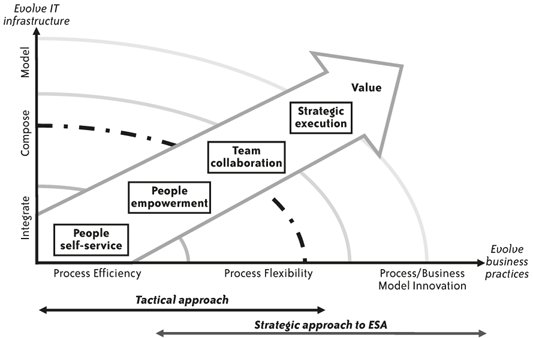Section 3.15. What will the shift to a model-driven world mean for IT, and where will these business analysts come from?
3.15. What will the shift to a model-driven world mean for IT, and where will these business analysts come from?What sets ESA apart from vanilla SOAs is its inclusion of a semantic business language expressed through enterprise servicesand, more important, how these are mapped to real business processesin the form of models. Modeling is the organizing principle of ESA; model-driven development tools will create composite applications that business analysts can build and rebuild, and these business analysts will lead the cultural shift away from siloed corporate hierarchies and toward a corporate organization aligned along business processes. When we say ESA will transform your culture, we're really talking about the change in perception stemming from the dominance of the modeling metaphor focused on processes. Modeling tools such as SAP Visual Composer are already used to hide complexity and simplify developers' choices when composing new UIs. Other tools also are available for high-level business processes (ARIS models from IDS Scheer), for frontend, conversational, user-centric business processes (guided procedures), for backend business processes (SAP NetWeaver Exchange Infrastructure's Cross Component Business Process Management), and for configuring business processes (SAP Solution Manager). Various abstraction layers such as Web Dynpro provide more detailed representations of an abstract UI that can be used by modeling tools. As we explain in more detail in Chapter 4, modeling makes development simpler, makes it easier to change applications, and helps support many platforms with less work. A new breed of business analysts, discussed in the previous chapter and elsewhere throughout the book, will handle modeling at the business process level. These business analysts represent the final, complementary fusion of the business and IT sides of a given corporation. Recruited from the business side of the operation, these analysts will be the detail-oriented staff already focused on real-world business processes and the workflow patterns they shape. They will have been sufficiently steeped in the language and in the essence of IT that real conversations are possible about the limits, possibilities, and opportunities presented by the underlying enterprise services. However, they will be shielded from the level of granularity familiar to IT's composition group, which will work with the analysts to assemble services into composite applications of appropriate flexibility and complexity. This vision presents only one problem at the moment: business analysts are in short supply. And when people with the needed skills are in an organization, they are sometimes reluctant to take the lead. Figure 3-10 shows one possible progression of empowerment, but there will be many. A new class of business executive will need to be trained in IT, integrated into the organization, and granted broad powers over the day-to-day operations of critical business units. While they may be critical to the ESA vision, analysts' institutional and cultural impacts on their respective companies are still a wide-open question. Will they be culled from the ranks of existing managers and be retrained? Or will they be recruited from future generations of MBA graduates? Will they work alongside traditional general managers, or is "business analyst" a retrained general manger by another name? You won't find the answers here because there aren't any. Each company that adopts ESA will have to answer these questions on its own, choosing a model, so to speak, that's most appropriate for it. These questions will cascade down the architecture as functionality and decision-making powers previously centralized in IT are reduced to services available anywhere within the enterprise. To give just one brief example, consider a model borrowed from Chapter 11. Analytical tools are key to ESA, which, if nothing else, will generate new torrents of data and automated messaging requiring filters and routing mechanisms, a task which today's massive, centralized data warehouses were never designed to perform. Do you see the organizational and technical challenges mounting? In order to capitalize on the flexibility and model-driven nature of ESA, a new class of users will need to be trained to harness it. In order for those users to make sense of the models they receive, they'll need more tools which have yet to be built, which means IT will need to learn how to build them, and after that, the analysts will need to be trained to use them.... The educational and organizational challenges should not be underestimated. Figure 3-10. ESA's path to people productivity One way of confronting the complexity involved without feeling overwhelmed by it is to consider ESA as a set of both tactical and strategic initiatives. Early in the adoption process, a focus on integration and process efficiency leads to the empowerment of individuals. But as IT begins to flex its new composition-based muscles and business processes begin to migrate across and outside the enterprise, the skills acquired from doing both begin to yield results at the team level, leading to strategic change as new groups, processes, and so on, are incorporated into previously static, stable processes. In other words, users will acquire skills and sophistication as they go along, which will propel the next cycle of innovation. |
EAN: 2147483647
Pages: 265